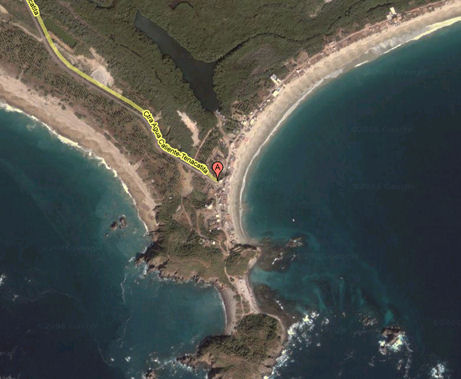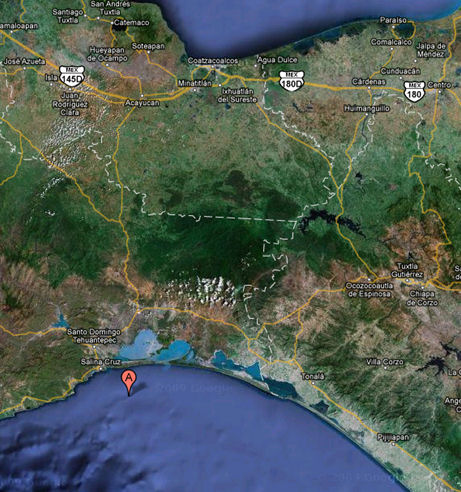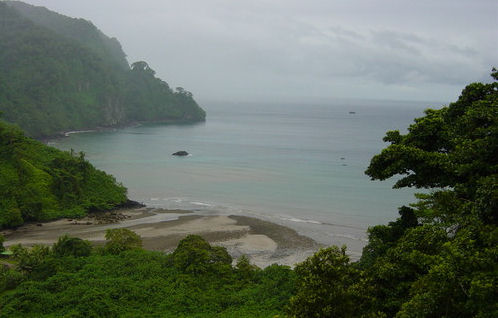Fleming 65 Cruises to Jurassic Park
Park rangers on the World Heritage
island of Isla del Coco make sure everyone is off the island before night fall.
Fleming was only too happy to get back aboard. We don’t know whether T-Rex still
roams there or not, but it was a great place for 17th century pirates and ill-gotten
loot has been found there. On the way south, the Fleming 65 braved the infamous
Gulf of Tehuantepec winds that old salts call Tehuantepekers. Fleming is a man on
a shakedown mission racing through paradise.
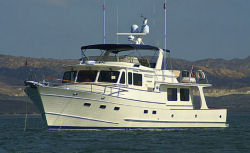 Tony Fleming takes Fleming 65 down the Mexican coast and ends up on the island that inspired the movie Jurassic Park. |
Read review of Fleming 65…
Tony Fleming Writes—
We left the La Paz area on April 12, 2008, and our first stop was at Puerto Vallarta
on the Mexican mainland. Here we had a rendezvous with another Fleming 65 for a
photo shoot from a helicopter.
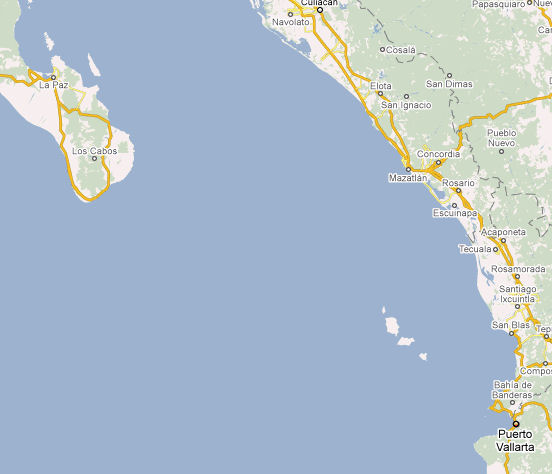 From La Paz it is about 400 nautical miles to Puerto Vallarta, a sleepy town made famous when The Night of the Iguana was made there decades ago. |
After enjoying the restaurants and amenities of the town we continued south [180
![]() to Tenacatita where we anchored in a small bay just off a small resort. The
to Tenacatita where we anchored in a small bay just off a small resort. The
whole of this coast is exposed to the full force of the Pacific Ocean which makes
landing a tender a real challenge on any beach. The normal hard-bottomed rib with
control console and large engine is quite unsuitable for this purpose and a small,
flat-bottomed tender with a small engine and fold-up wheels is a must. It can be
deflated when not in use and carried in addition to the main tender.
The main feature at Tenacatita is a ride in the tender through the mangroves to
a lagoon backing onto a beach which would be hard to access from the ocean. There
is a bar at the entrance to the estuary which can only be crossed when the tide
is high. Thereafter the river narrows down until you find yourself in a green tunnel
ducking your head beneath overhanging branches which could decapitate you. To add
to the fun, you are likely to meet local pangas speeding the other way around blind
corners. Truly a memorable experience.
Our next stop was at Huatulco [about 600 miles ![]() where we tied up at the modern
where we tied up at the modern
marina with helpful staff. We visited the charming nearby town and its restaurants.
Everyone we met was exceptionally friendly and nice and in fact this was true of
all the places we stopped at along the Mexican coast. Huatulco is at the northern
end of the infamous Gulf of Tuantapec.
Gulf of Tuantapec
The landmass of Central America is very narrow at this point and north-easterly
winds from the Gulf of Mexico are funneled across this narrow neck of land through
a gap in the mountains and turn the Gulf of Tuantapec into a maelstrom for as far
as 200 miles out to sea. Some cruising boats stay as close as ¼ mile off the beach
to escape its fury. We were lucky and a check of the weather showed that it was
safe for us to make the gulf crossing.
Unfortunately our schedule did not allow us to dally and we headed directly for
Los Suenos in Costa Rica which meant traveling non-stop for 96 hours. Along the
way, when we were 70 miles offshore, we met fierce Papagayo winds which churned
up the sea.
Costa Rica – Non-Stop
Los Suenos has a Marriott resort overlooking a modern marina which is packed with
sports fishing boats all in immaculate condition as they are washed and their needs
attended to on a daily basis by an army of industrious boat hands. We stayed here
for a few days awaiting a change of crew and preparing ourselves and Venture for
the long excursion out into the Pacific Ocean.
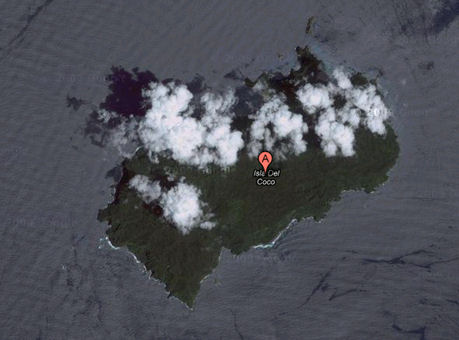 Isla del Coco as seen from a eye in the sky. This island was the inspiration for the novel Jurassic Park by Michael Crichton, and the Spielberg movie. |
Our first stop was Isla del Coco - just a miniscule dot in the immensity of the
ocean. Coco lies almost 300 miles offshore and is administered by Costa Rica. With
the help of GPS and a modern charting program Coco loomed right ahead at just the
time it should. The steep, forested flanks of this tropical island were shrouded
in mist as we arrived in Chatham Bay giving it a lost world appearance. There were
a couple of dive boats anchored in the bay. We were called on the radio by someone
from a barely visible hut on shore and instructed to pick up one of the moorings
with yellow floats.
The following morning a park ranger came on board and examined our paperwork. He
also had a DVD for us to watch on the spot describing the rules of the national
park. Only the rangers sleep ashore; all visitors have to stay aboard the boats
which bring them to the island. The ranger was very friendly and we arranged later
that morning to take a guide and walk through the forest to a waterfall.
To start the trek we took the tender around to another bay and over a shallow bar
into the mouth of a small river. I have to say that I found the trek extremely arduous
as the rough track wound its way uphill through the heat and humidity of the tropical
jungle. The last few yards involved forging through knee deep water and scrambling
over slippery boulders.
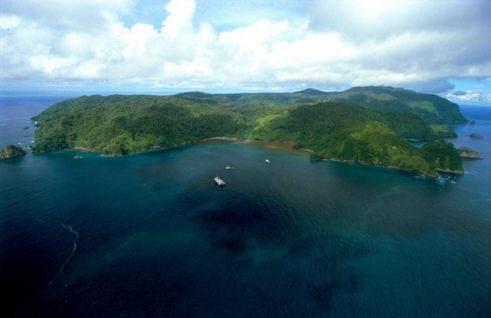 The waters off the island are world famous for having the largest schools of hammerhead sharks and PADI has designated it a “must” for world-class scuba divers. |
[Cocos Island was designated a World Heritage Site by UNESCO in 1997. In 2002, the
World Heritage Site designation was extended to include an expanded marine zone
of 1,997 km². In addition, it is included in the list of "Wetlands of International
Importance". Cocos Island was short-listed as a candidate to be one of the New 7
Wonders of Nature by the New Seven Wonders of the World Foundation. Thanks to the
breathtaking marine life in its waters (see Fauna section below), Cocos Island was
named one of the best 10 scuba diving spots in the world by PADI (Professional Association
of Diving Instructors) and a "must do" according to diving experts.The only persons
allowed to live on Cocos Island are Costa Rican Park Rangers, who have established
two encampments, including one at English Bay. Tourists and ship crew members are
allowed ashore only with permission of island rangers, and are not permitted to
camp, stay overnight or collect any flora, fauna or minerals from the island.—Ed.]
The following morning we got underway once again for the Galapagos which lay another
440 miles out in the Pacific. We crossed the Equator at 3 AM on the morning of May
6th and we were all in the pilothouse to record the event.
In the next Offshore Motoryacht Edition: The Galapagos Islands
